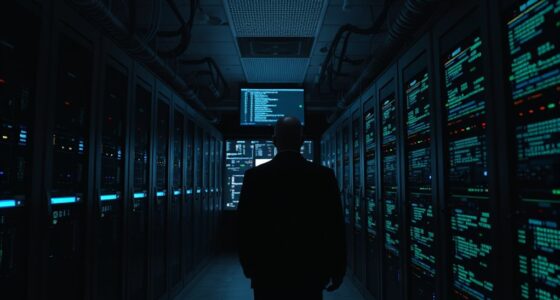The National Geospatial-Intelligence Agency (NGA) uses advanced aerial and satellite technologies to gather critical geospatial data. You benefit from their ability to monitor large areas, detect threats, and support emergency responses in real time. Their layered approach combines persistent satellite imagery with targeted aerial reconnaissance, providing detailed, actionable intelligence. If you want to explore how these eyes in the sky work together to protect national security, there’s much more to discover ahead.
Key Takeaways
- The NGA provides geospatial intelligence to support national security, defense, and humanitarian efforts.
- It utilizes satellite imaging and aerial reconnaissance to gather detailed, real-time geographic data.
- The agency analyzes imagery to detect threats, monitor natural resources, and assist military operations.
- NGA integrates data from multiple sources to create comprehensive, layered situational awareness.
- Its mission enhances decision-making and rapid response through advanced geospatial analysis technologies.

Have you ever wondered how modern surveillance systems keep an eye on everything from above? “Eyes in the Sky” explores the rapidly advancing world of aerial monitoring, where drones, satellites, and aircraft work together to enhance security, gather intelligence, and monitor the environment. Central to this effort is the use of satellite imaging and aerial reconnaissance, tools that provide crucial insights from above. When you think about satellite imaging, imagine a network of satellites orbiting Earth, capturing high-resolution images across vast regions in real time. These images reveal details invisible from the ground, such as troop movements, illegal activities, or environmental changes. Satellite imaging offers a bird’s-eye view that’s both all-encompassing and precise, enabling analysts to detect patterns and anomalies that might otherwise go unnoticed. This capability is essential for national security, disaster response, and resource management. Aerial reconnaissance complements satellite imaging by deploying aircraft, drones, and other aerial platforms to gather intelligence at closer ranges or in specific areas of interest. Unlike satellites, which cover broad swaths of territory from space, aerial reconnaissance can focus on targeted zones, providing real-time data with greater flexibility. You might see reconnaissance aircraft flying low over border regions or surveillance drones hovering over conflict zones, collecting live video feeds and detailed imagery. These aerial assets can adapt quickly to changing circumstances, offering immediate intelligence for decision-makers. The combination of satellite imaging and aerial reconnaissance creates a layered approach to surveillance. Satellites provide a broad, persistent view of large-scale activities, while aerial platforms offer detailed, focused insights into specific incidents or locations. This integration allows you to have a clearer picture of complex situations, whether monitoring a natural disaster or tracking clandestine operations. The data collected from these aerial sources feeds into sophisticated analysis systems, which help interpret the images and videos. This process involves advanced algorithms, machine learning, and human expertise, all working together to turn raw imagery into actionable intelligence. As technology advances, the capabilities of satellite imaging and aerial reconnaissance continue to expand, becoming more precise, faster, and more resilient. You’re now able to monitor the environment, enforce borders, support military operations, and respond to emergencies with unprecedented accuracy and timeliness. The National Geospatial-Intelligence Agency harnesses these tools to safeguard national interests and contribute to global stability. Furthermore, high-resolution imaging technology is constantly improving, allowing for even more detailed and accurate data collection. In this high-tech landscape, aerial monitoring remains an indispensable element, ensuring you’re better informed and more prepared than ever before.
Frequently Asked Questions
How Does NGA Collaborate With International Intelligence Agencies?
You collaborate with international intelligence agencies through strong international partnerships and data sharing agreements. These collaborations enable you to exchange geospatial information, enhance global security, and improve situational awareness. By working closely with allies, you guarantee timely access to critical intelligence, support joint operations, and strengthen global security efforts. This cooperative approach helps you stay ahead of emerging threats and promotes mutual understanding among nations.
What Are the Technological Challenges Faced by Nga’s Satellite Systems?
You face technological challenges with NGA’s satellite systems, especially regarding satellite calibration and data latency. Maintaining precise calibration guarantees accurate imagery, but it’s complex and requires constant adjustments. Data latency delays real-time access to critical information, impacting intelligence operations. Overcoming these issues demands advanced technology and constant monitoring, so you can deliver reliable, timely geospatial data essential for national security and strategic decisions.
How Does NGA Ensure the Security of Its Geospatial Data?
Like a fortress guarding its crown jewels, NGA secures its geospatial data through robust data encryption and strict access controls. You’re kept safe by layered security measures, ensuring only authorized personnel access sensitive information. They continuously update encryption protocols and monitor access points, preventing breaches. This vigilant approach, akin to a watchful sentinel, guarantees your data remains protected from cyber threats and unauthorized intrusions.
What Training Is Required for NGA Personnel Operating Space-Based Assets?
You need specialized training in satellite operation and data analysis to work with NGA’s space-based assets. This includes understanding satellite systems, remote sensing technology, and secure communication protocols. You’ll also learn how to interpret geospatial data accurately and efficiently. Continuous education and hands-on experience are essential to stay current with evolving technology. Your training guarantees you can operate satellites safely and analyze data effectively for national security and intelligence missions.
How Is NGA Adapting to Emerging Remote Sensing Technologies?
You see NGA adapting to emerging remote sensing technologies by integrating Artificial Intelligence and advanced Data Integration techniques. They actively develop AI algorithms to analyze vast data streams quickly, improving real-time decision-making. NGA also enhances data integration across multiple platforms, ensuring seamless access to diverse imagery sources. This proactive approach helps you stay ahead in geospatial intelligence, leveraging cutting-edge tech to provide accurate, timely insights critical for national security.
Conclusion
As you look to the horizon, remember that the National Geospatial-Intelligence Agency gently watches over us, quietly guiding and protecting with unseen eyes. Like a caring guardian, it paints a picture of our world from above, ensuring safety without disturbance. Though its presence is subtle, its role is crucial—an ever-watchful eye that helps us navigate the complexities of our world, all while remaining in the background, softly illuminating the path forward.








